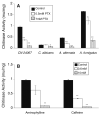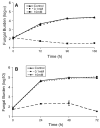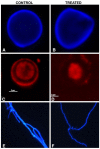Methylxanthine inhibit fungal chitinases and exhibit antifungal activity
- PMID: 21968902
- PMCID: PMC4289597
- DOI: 10.1007/s11046-011-9483-x
Methylxanthine inhibit fungal chitinases and exhibit antifungal activity
Abstract
Chitinases are necessary for fungal cell wall remodeling and cell replication. Methylxanthines have been shown to competitively inhibit family 18 chitinases in vitro. We sought to determine the effects of methylxanthines on fungal chitinases. Fungi demonstrated variable chitinase activity and incubation with methylxanthines (0.5-10 mM) resulted in a dose-dependent decrease in this activity. All fungi tested, except for Candida spp., demonstrated growth inhibition in the presence of methylxanthines at a concentration of 10 mM. India ink staining demonstrated impaired budding and decreased cell size for methylxanthine-treated Cryptococcus neoformans. C. neoformans and Aspergillus fumigatus treated with pentoxifylline also exhibited abnormal cell morphology. In addition, pentoxifylline-treated C. neoformans exhibited increased susceptibility to calcofluor and a leaky melanin phenotype consistent with defective cell wall function. Our data suggest that a variety of fungi express chitinases and that methylxanthines have antifungal properties related to their inhibition of fungal chitinases. Our results highlight the potential utility of targeting chitinases in the development of novel antifungal therapies.
Figures







Similar articles
-
Methylxanthine drugs are chitinase inhibitors: investigation of inhibition and binding modes.Chem Biol. 2005 Sep;12(9):973-80. doi: 10.1016/j.chembiol.2005.07.009. Chem Biol. 2005. PMID: 16183021
-
Acetazolamide-based fungal chitinase inhibitors.Bioorg Med Chem. 2010 Dec 1;18(23):8334-40. doi: 10.1016/j.bmc.2010.09.062. Epub 2010 Oct 8. Bioorg Med Chem. 2010. PMID: 21044846 Free PMC article.
-
Crystal structure and mutagenesis analysis of chitinase CrChi1 from the nematophagous fungus Clonostachys rosea in complex with the inhibitor caffeine.Microbiology (Reading). 2010 Dec;156(Pt 12):3566-3574. doi: 10.1099/mic.0.043653-0. Epub 2010 Sep 9. Microbiology (Reading). 2010. PMID: 20829286
-
Searching for new-type antifungal drugs (an outline for possible new strategies).Acta Microbiol Immunol Hung. 2001;48(3-4):533-43. doi: 10.1556/AMicr.48.2001.3-4.19. Acta Microbiol Immunol Hung. 2001. PMID: 11791350 Review.
-
Novel methylxanthine derivative-mediated anti-inflammatory effects in inflammatory bowel disease.World J Gastroenterol. 2014 Feb 7;20(5):1127-38. doi: 10.3748/wjg.v20.i5.1127. World J Gastroenterol. 2014. PMID: 24574789 Free PMC article. Review.
Cited by
-
Traversing the Cell Wall: The Chitinolytic Activity of Histoplasma capsulatum Extracellular Vesicles Facilitates Their Release.J Fungi (Basel). 2023 Oct 27;9(11):1052. doi: 10.3390/jof9111052. J Fungi (Basel). 2023. PMID: 37998859 Free PMC article.
-
Molecular Topology QSAR Strategy for Crop Protection: New Natural Fungicides with Chitin Inhibitory Activity.ACS Omega. 2020 Jun 26;5(27):16358-16365. doi: 10.1021/acsomega.0c00177. eCollection 2020 Jul 14. ACS Omega. 2020. PMID: 32685798 Free PMC article.
-
Melanin Induction Restores the Pathogenicity of Gaeumannomyces graminis var. tritici in Wheat Plants.J Fungi (Basel). 2023 Mar 14;9(3):350. doi: 10.3390/jof9030350. J Fungi (Basel). 2023. PMID: 36983518 Free PMC article.
-
Therapeutic effects of pentoxifylline on invasive pulmonary aspergillosis in immunosuppressed mice.BMC Pulm Med. 2021 Jan 19;21(1):31. doi: 10.1186/s12890-021-01396-8. BMC Pulm Med. 2021. PMID: 33468116 Free PMC article.
-
Melanin in fungi: advances in structure, biosynthesis, regulation, and metabolic engineering.Microb Cell Fact. 2024 Dec 19;23(1):334. doi: 10.1186/s12934-024-02614-8. Microb Cell Fact. 2024. PMID: 39696244 Free PMC article. Review.
References
-
- Duo Chuan L. Review of fungal chitinases. Mycopathologia. 2006;161(6):345–60. - PubMed
-
- Boot RG, Blommaart EF, Swart E, Ghauharali-van der Vlugt K, Bijl N, Moe C, et al. Identification of a novel acidic mammalian chitinase distinct from chitotriosidase. J Biol Chem. 2001;276(9):6770–8. - PubMed
-
- van Eijk M, van Roomen CP, Renkema GH, Bussink AP, Andrews L, Blommaart EF, et al. Characterization of human phagocyte-derived chitotriosidase, a component of innate immunity. Int Immunol. 2005;17(11):1505–12. - PubMed
Publication types
MeSH terms
Substances
Grants and funding
LinkOut - more resources
Full Text Sources
Other Literature Sources
Medical
Miscellaneous

